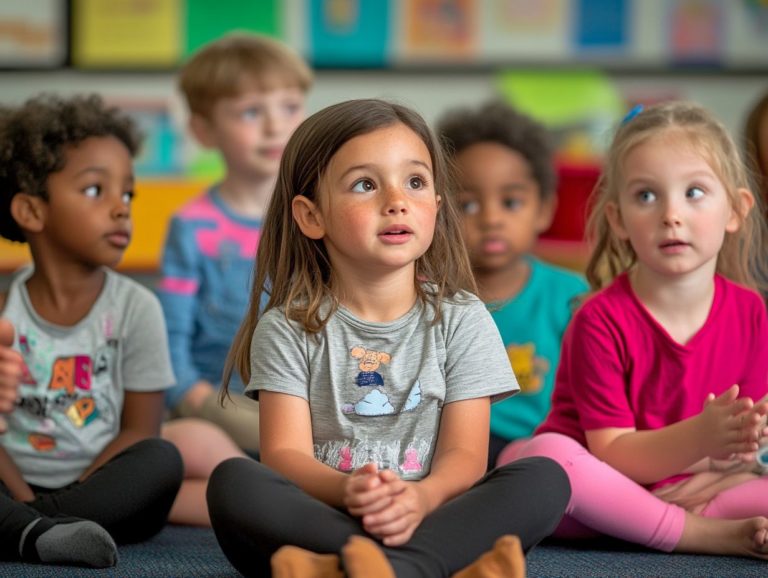Creating a Safe Space for Conversations
Contents
- Creating Safe Spaces for Meaningful Conversations
- Key Takeaways:
- What Is a Safe Space?
- Why Is a Safe Space Important?
- What Are the Characteristics of a Safe Space?
- 5. Non-judgmental Attitude
- How Can You Create a Safe Space for Conversations?
- What Are Some Topics That Can Be Discussed in a Safe Space?
- Creating Safe Spaces for Conversations
- Frequently Asked Questions
- Creating Safe Spaces for Dialogue
Creating Safe Spaces for Meaningful Conversations
In today s fast-paced world, fostering open dialogue is more crucial than ever. A safe space is a supportive environment where you can express your thoughts and feelings freely, without the looming fear of judgment. Such spaces encourage youth engagement and allow for the discussion of difficult topics.
This article delves into the definition and significance of safe spaces. It sheds light on the key characteristics that contribute to their effectiveness. You will uncover practical tips on how to create these spaces and explore the diverse topics that can be addressed within them, such as racism, mental health, and social responsibility. Join us as you discover the essentials of cultivating meaningful conversations!
Key Takeaways:

- Create a space where everyone feels respected and included.
- Practice listening actively and validate each other’s feelings.
- Discuss important topics like mental health and social responsibility openly.
What Is a Safe Space?
A safe space is an environment that offers you, especially as a young person, a profound sense of feeling safe to share your thoughts and emotional security. Here, you have the freedom to communicate openly, without the fear of judgment or negative repercussions.
This concept is particularly crucial in youth programs, where responsible adults and trained youth workers cultivate an atmosphere that encourages civil dialogue and helpful conversations on challenging topics.
In these supportive spaces, you can express your thoughts and feelings freely. This fosters enhanced collaboration, understanding, and respect for diverse perspectives. These practices are supported by frameworks developed by organizations like Facing History and Ourselves and the David P Weikart Center.
Why Is a Safe Space Important?
Creating a safe space is essential for nurturing psychological safety among youth. It allows individuals to express their thoughts and emotions freely, paving the way for meaningful conversations and open communication on important topics like mental health and social responsibility.
In environments where active listening is paramount and emotional safety is assured, youth are enabled to share their ideas and engage in constructive dialogue. They also refine their communication skills.
This commitment to inclusivity fosters personal growth and strengthens community bonds. It encourages diverse perspectives and collaborative problem-solving. It also helps in building leadership skills and understanding differences within the group.
What Are the Characteristics of a Safe Space?
A safe space embodies key characteristics such as inclusivity, respect, confidentiality, open-mindedness, and a non-judgmental attitude. These elements are vital for cultivating an environment that promotes honest and meaningful conversations.
In youth programs, these traits encourage group cohesion and collaboration. They enable individuals to delve into challenging subjects while feeling secure in their vulnerability.
By committing to these principles, you can engage in respectful debates and constructive dialogues. This significantly enhances the overall effectiveness of the space.
1. Inclusivity
Inclusivity in a safe space means that you actively welcome and validate diverse viewpoints. This ensures that all participants feel valued and heard, no matter their backgrounds or experiences.
This commitment to inclusivity is essential, especially in youth engagement initiatives. It encourages young people to express themselves freely, confident that their opinions and identities are respected.
By nurturing such an environment, you can strengthen community bonds and cultivate a genuine sense of belonging.
Techniques like collaborative workshops and open dialogue forums enhance participation. These methods promote understanding and allow you to become an agent of change within your community, fostering an atmosphere where every voice enriches the collective narrative.
Such techniques also help in addressing conflict and promoting social responsibility.
2. Respect
Respect is the cornerstone of a safe space. It allows you to express your opinions while honoring others perspectives, leading to more productive dialogue.
Effective participation and clear communication are key to fostering this environment.
This atmosphere of mutual respect allows differing viewpoints to be shared freely, without the looming fear of ridicule or hostility. This is essential for fostering meaningful interactions.
For instance, in discussions about climate change, actively listening shows respect for diverse opinions. It encourages richer conversations.
When someone shares their perspective on renewable energy, you can show respect by asking clarifying questions rather than challenging their view outright. This type of engagement enriches the conversation and cultivates a deeper understanding among participants.
3. Confidentiality
Confidentiality maintains emotional safety, allowing you to share your thoughts without judgment. This principle is reinforced through workshops and group agreements.
This foundational principle holds particular significance in youth programs, where building trust among participants can lead to richer discussions and deeper personal growth.
When young individuals understand that their shared experiences and emotions are safeguarded, they are far more likely to engage openly. This creates a space where effective communication can flourish.
This environment promotes honesty and fosters a strong sense of community, enabling participants to support each other on their individual journeys.
Ultimately, confidentiality serves as a catalyst for forging deeper connections, nurturing growth and understanding within the group.
4. Open-mindedness

Open-mindedness creates constructive dialogue in a safe space. It allows you to explore different perspectives and engage meaningfully.
Consider a classroom setting: a teacher who embodies open-mindedness encourages students to share their opinions. This nurtures critical thinking and mutual respect.
This approach deepens understanding and creates a culture of learning and growth, as you and your peers come to appreciate the richness of diverse viewpoints.
By actively listening and striving to understand varying perspectives, you can transform the dynamics of communication, leading to more enriching conversations and stronger connections with others.
Join us in this journey!
5. Non-judgmental Attitude
Adopting a non-judgmental attitude is essential for cultivating an environment where you feel at ease expressing your vulnerabilities and engaging in genuine conversations. This atmosphere builds trust and encourages active listening, enabling a richer understanding of diverse perspectives and personal beliefs.
When you sense that your thoughts will be received without criticism, you’re more inclined to open up, share insights, and collaboratively explore solutions. These interactions enhance your communication skills by nurturing empathy and patience, both vital for effective conflict resolution.
In such a setting, you can tackle misunderstandings and disagreements constructively, paving the way for meaningful dialogue that fosters personal growth and strengthens relationships.
How Can You Create a Safe Space for Conversations?
Creating a safe space for conversations requires implementing strategic ground rules, fostering active listening, and encouraging teamwork among participants. This environment supports youth workers and caring adults in nurturing youth development.
This approach ensures that everyone feels comfortable sharing their thoughts and ideas openly.
1. Set Ground Rules
Setting ground rules provides a framework for respectful debate, facilitates group agreement, and enhances communication among participants. Clearly defined rules foster an atmosphere where everyone feels valued and heard.
Consider implementing effective rules such as:
- Encouraging active listening
- Allowing one person to speak at a time
- Focusing on the issue rather than personal attacks
These guidelines minimize misunderstandings and conflicts, ensuring that discussions remain constructive. Emphasizing confidentiality promotes openness, enabling participants to express themselves without fear of judgment. Meeting strategies and feedback mechanisms also play a crucial role in this process.
By creating this supportive environment, you pave the way for truly meaningful dialogue, fostering collaboration and mutual respect among all involved.
2. Encourage Active Listening
Encouraging active listening is crucial for fostering emotional safety. It allows you to engage fully with the thoughts and feelings of others, reinforcing a sense of community inclusion. This process is vital for cultivating group dynamics and enhancing dialogue.
Creating an atmosphere where everyone feels heard and valued enables individuals to express their ideas without the shadow of judgment. Implementing techniques like reflective listening where you paraphrase or summarize what someone has shared can significantly enhance mutual understanding.
Using open-ended questions invites deeper discussions and demonstrates a genuine interest in others’ perspectives. Paying attention to non-verbal cues, such as maintaining eye contact and nodding, further cultivates a climate of respect and care.
When you prioritize active listening, you ll notice improved group dynamics, leading to stronger connections and more effective collaborative problem-solving.
3. Use ‘I’ Statements
‘I’ statements are a powerful communication tool that enables you to articulate your feelings and perspectives without casting blame. This fosters vulnerability and genuine conversations.
By concentrating on your personal experiences instead of making generalizations, you create an environment of safety and openness. For example, instead of saying, “You never listen to me,” you might express, “I feel unheard when I try to share my thoughts.” This subtle rephrasing can turn a confrontational comment into an opportunity for constructive dialogue.
Practicing ‘I’ statements enhances understanding between you and others, leading to more meaningful exchanges. Applying this technique in personal and professional interactions can significantly improve relationships, lessen defensiveness, and nurture empathy.
4. Acknowledge and Validate Feelings
Acknowledging and validating your feelings is essential in creating a safe space, as it nurtures emotional safety and encourages active participation from everyone involved.
By embracing this practice, you can help cultivate an environment where participants feel truly valued and understood. When emotions are openly recognized, it paves the way for more honest and constructive dialogue, allowing individuals to express themselves without the looming fear of judgment.
This approach not only enhances feedback mechanisms but also strengthens interpersonal communication within the group. By emphasizing the significance of emotional awareness, you foster trust among participants, leading to more meaningful interactions and a richer exchange of ideas.
Ultimately, such validation transforms discussions into valuable opportunities for growth and collaboration.
5. Provide Resources

Providing resources is essential in creating a safe space, equipping you with the tools and information needed to navigate challenging conversations and foster a sense of community support.
These resources can take many forms, from informative pamphlets to online courses and interactive workshops, all designed to deepen your understanding of important issues. Utilizing facilitation techniques such as active listening and open-ended questioning is fundamental in encouraging meaningful dialogue among participants.
Incorporating multimedia tools like engaging videos and discussion forums can further stimulate your engagement, creating a more interactive learning environment. By arming youth with these resources, programs not only promote critical thinking but also enable you to express your perspectives confidently, ultimately leading to enriched discussions and stronger community bonds.
What Are Some Topics That Can Be Discussed in a Safe Space?
In a safe space, you have the opportunity to engage in meaningful discussions on a wide array of significant topics, such as mental health, diversity and inclusion, and social issues. This environment not only fosters personal growth but also encourages a sense of community inclusion.
1. Mental Health
Mental health is a significant topic that deserves to be openly discussed in a safe environment, where you can share your experiences and receive support from those around you.
Creating spaces that prioritize emotional safety is essential for fostering authentic conversations. In these supportive networks, you can express your feelings without the fear of judgment, which paves the way for healing and understanding. Emotional safety invites vulnerability, allowing you to confront the stigma and shame often tied to mental health challenges. These discussions not only promote your personal growth but also nurture a sense of community, enableing you to forge deeper connections with others.
As these safe spaces flourish, they play a crucial role in cultivating resilience and enhancing your overall well-being.
2. Diversity and Inclusion
Engaging in discussions about diversity and inclusion within a safe space invites you to explore and appreciate the differences that make each person unique, fostering a genuine sense of community and belonging.
These conversations can ignite a transformative process for building trust and enhancing psychological safety, allowing you to share your unique perspectives without the looming fear of judgment. When you and your fellow community members engage in open dialogue about your varied backgrounds, experiences, and cultural norms, you don t just expand your understanding of one another; you also cultivate empathy and respect.
This nurturing environment enables voices that might otherwise feel marginalized, leading to richer interactions and deeper collaboration. Ultimately, by fostering a culture of inclusivity, you not only strengthen the bonds of your community but also drive innovation by valuing the diverse viewpoints and solutions that emerge from it.
Creating Safe Spaces for Conversations
Creating a safe space for conversations is crucial for fostering meaningful dialogue. This environment allows individuals to express themselves freely and openly.
1. Relationships
Engaging in conversations about relationships in a safe space enables you to share your perspectives and enhance your communication skills.
Such environments cultivate trust and openness, essential for meaningful exchanges. When you feel secure, you are more inclined to express your thoughts and emotions, encouraging deeper understanding and valuable feedback.
By embracing honesty and vulnerability, you can engage in discussions that strengthen personal connections and refine your conflict resolution skills.
These interactions emphasize active listening and thoughtful responses, laying the foundation for fulfilling and supportive relationships. Safe spaces promote a culture of respect and empathy, vital for nurturing healthy relationships.
2. Social Issues
Addressing social issues in a safe space allows you to share your thoughts and experiences, fostering inclusion and social responsibility.
These environments encourage discussions about pressing topics like inequality, mental health, and environmental challenges, helping you express your views without fear of judgment.
Through these dialogues, you often find common ground with others, igniting collaborative efforts for meaningful change. Such discussions inspire actionable initiatives and greater motivation to advocate for your community.
Highlighting the importance of youth voices in these conversations nurtures a richer, interconnected society for everyone.
3. Personal Growth and Development
Personal growth thrives in a safe space where you can explore vulnerabilities and engage without fear of judgment.
These environments provide emotional safety, enabling authentic self-expression. In nurturing settings, you are encouraged to take risks and confront challenges, fostering community and belonging.
Vulnerability leads to deeper connections as you learn from the experiences of others. This collective journey reinforces personal resolutions and builds resilience, empathy, and interpersonal skills that enhance both personal and professional life.
Ultimately, you become a well-rounded individual, better equipped to navigate life’s complexities.
Frequently Asked Questions

What is the importance of creating a safe space for conversations?
Creating a safe space allows individuals to express themselves freely, promoting open communication that leads to better understanding and conflict resolution.
How can I create a safe space for conversations in my workplace?
Start by establishing ground rules that promote respect and active listening. Encourage open communication and ensure everyone’s opinions are heard and valued. Make it clear that any discriminatory or offensive language will not be tolerated.
What should I do if someone violates the psychological safety of the safe space for conversations?
Address the situation immediately, reminding everyone of the ground rules. If the violation continues, consider having a private conversation with the individual to discuss their behavior. Involving caring adults or youth workers to mediate can be helpful. Emphasizing group dynamics and social responsibility can aid in effectively addressing conflicts.
Share your thoughts or experiences in creating safe spaces!
Creating Safe Spaces for Dialogue
Can disagreements still occur in a safe space for civil dialogue?
Yes, disagreements can still occur. In a safe space for civil dialogue, individuals are encouraged to express their opinions respectfully and listen to others’ perspectives.
This can lead to a healthy and productive discussion rather than a heated argument. Understanding differences, using effective communication skills, and considering multiple perspectives can help in conflict resolution and maintaining an inclusive environment.
How can I ensure that everyone feels comfortable in the safe space for meaningful conversations?
Make sure to create an inclusive environment where everyone’s thoughts and feelings are respected. Use inclusive language and avoid making assumptions about others.
Encourage individuals to speak up if they feel uncomfortable and address any concerns that arise. Building trust and teamwork helps everyone feel safe and participate actively.
Can a safe space for honest conversations be created online?
Absolutely! We can create a safe online space for honest conversations using the right tools and rules. A safe space for honest conversations can be created online by using platforms that allow for private and respectful communication, such as video conferencing tools or online forums.
It is important to set ground rules and monitor the conversation to ensure everyone feels safe and respected. Using collaboration tools and engagement techniques can also help facilitate constructive dialogue on important topics like mental health, gun violence, or cultural discussions.
Institutions like Facing History and Ourselves or the University of Minnesota can offer valuable resources and workshops for creating and maintaining these safe spaces.
Creating and fostering these environments is crucial for effective dialogue and understanding among individuals.






